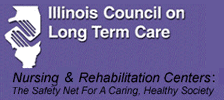|

Illinois
Council on Long Term Care
Illinois Health Care Association
Life Services Network of Illinois
FOR IMMEDIATE RELEASE
October 18, 2006
100%
of Illinois Legislative Candidates Support Updating
Nursing Home Medicaid Costs
CHICAGO – One hundred
percent of 61 state candidates responding to a recent
survey feel that Illinois should update Medicaid
payments to nursing homes for the basics of care to
current cost levels.
“Currently, nursing homes are
being paid for Medicaid services based on cost levels
from 1999,” said Terrence Sullivan, executive director
for the Illinois Council on Long Term Care.
“Illinois’ state candidates agree that these costs
should be updated to 2005 levels, the latest cost
information that’s available, to ensure that nursing
home residents receive the quality care they deserve.”
The Illinois Council on Long Term
Care, the Illinois Health Care Association and Life
Services Network of Illinois recently distributed a
questionnaire about the key issues affecting the care of
nursing home residents to all state candidates running
for representative and senator.
Nursing homes have several core
responsibilities for meeting residents’ basic health
and quality of life needs, including making sure that
residents are well-nourished; using technology to
provide the highest quality of care; preventing the
spread of infectious diseases; and ensuring that
residents are safe and secure.
The types of programs and
associated costs for these basics of care have changed
greatly since 1999. For instance:
Making sure residents are
well-nourished: Dozens of Illinois nursing homes
have abandoned the traditional, “hospital-like” tray
service to offer residents a variety of delicious food
choices through buffet and restaurant-style dining.
Residents can choose from several tempting options
including soups, salads, entrees and desserts. Some
residents want to choose food items for themselves,
while others appreciate receiving wait service from the
staff. Being able to make their own choices augments the
residents’ desire to eat and adds to their enjoyment
of life.
Using technology to provide the
highest quality of care: Today’s nursing homes
provide many forms of advanced medical care that used to
only be provided in hospitals. This high-level medical
care requires state-of-the-art technology, including
ventilators, pressure-reducing beds, dialysis machines,
IV units, chemotherapy equipment, heart monitors, and
Nautilus equipment for physical rehabilitation. In
addition, facilities use computer systems for a variety
of medical-related functions, including resident
assessments and care planning.
Preventing the spread of
infectious diseases: In the 21st century,
long term care facilities are having to fight
“superbugs” like they never had to before, including
serious infections like MRSA, VRSA, and flesh-eating
disease. Patients who used to stay in the hospital with
their infectious diseases are now coming to nursing
homes instead for their extended care. Thousands of
today’s nursing home residents require strict
isolation procedures, involving patients staying in
private rooms; staff wearing masks, gowns and gloves;
and facilities administering costly IV antibiotics
because oral medications are no longer effective.
Ensuring that residents are safe
and secure: Recently,
the Illinois nursing home community worked hand-in-hand
with the Attorney General’s office and the
Governor’s office to develop the nation’s first
criminal background check regulations for nursing
home residents. These regulations require facilities
to run criminal background checks on every current and
new nursing home resident, and work with the Illinois
Department of Public Health and the State Police to
develop care plans of safety for any person who is an
identified offender. With these new regulations,
Illinois nursing homes are taking the lead in making
sure that resident safety and security are optimized.
However, this unfunded mandate will cost nursing homes
an additional $10 million.
“The long term care community has
changed greatly since 1999, and so have its costs,”
said Dave Voepel, executive director of the Illinois
Health Care Association. “Bringing Medicaid funding to
2005 cost levels will require $116 million, consisting
of $58 million in state General Revenue Funds and $58
million in federal match. This needed update in long
term care funding is long overdue.”
“Today’s nursing homes are
increasingly providing services that traditionally have
only been offered in hospitals,” said Dennis Bozzi,
President of Life Services Network. “Yet, Illinois
continues to fund these facilities like they are still
the `rest homes’ of years past. The time has come for
Illinois lawmakers to provide appropriate funding for
today’s medically complex nursing home population.”
#
# #
The state’s three long term care
associations – the Illinois Council on Long Term Care,
the Illinois Health Care Association, and Life Services
Network of Illinois – have joined together as the
Illinois Long Term Care Coalition to educate
policymakers about their commitment to care. This
coalition represents more than 60,000 healthcare
professionals, therapists and caregivers serving 80,000
residents in more than 800 specialized nursing and
rehabilitation facilities in Illinois.
|

